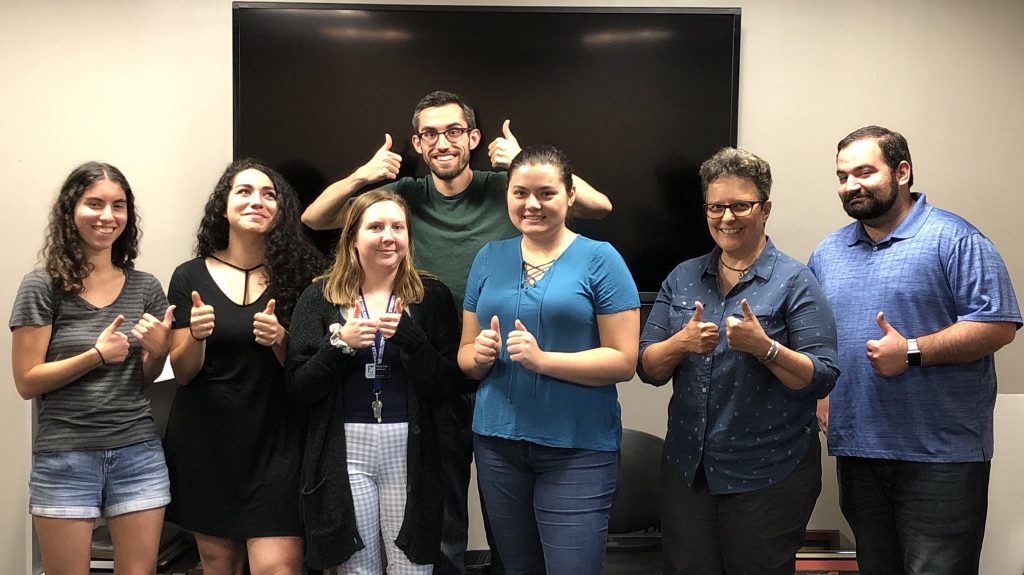CJC Alumnus Uses AI to Make Jobs Easier for Hearst Journalists
By Lenore Devore, B.S. Journalism, 1984
This is the first in a series of profiles of CJC alumni who are working with artificial intelligence.

University of Florida College of Journalism and Communications (UFCJC) alumnus Ryan Serpico, B.S. Journalism 2018, built his first generative artificial intelligence (AI) tool during weekends at a coffee shop, telling no one other than his girlfriend and father. That audience engagement tool, Producer-P, is now helping several Hearst Newspaper newsrooms.
The media company’s deputy director of Newsroom AI and Automation, a position he was promoted to in late March 2024, uses the latest developments in generative AI to assist journalists with their jobs, automating some time-consuming tasks so they can focus on issues. He’s part of the DevHub – a centralized team that helps five Hearst newsrooms (and supports others) create their own data-driven reports, interactives, templating systems and more.
The Pembroke Pines, Florida, native had not decided on a career path while attending Broward College. Katrice Graham, UFCJC assistant dean for student experiences and director of the Knight Division for Scholarships and Student Inclusion was on a recruiting visit to the school. She encouraged him to apply to UFCJC, where he could marry his passion for telling stories with his love of technology.
“I liked the latest gadgets and apps, but I was not great at math, so I thought programming was off-limits,” Serpico said. “Then Katrice came to visit. I’m a first-generation college student and I found going to the best journalism program in the state would be better than going to Florida International University.”
At UFCJC, he saw a flier for Journalism Professor Mindy McAdams’ class on building web apps. “I thought it would probably be good to know how the sausage is made; how it works. I fell down the rabbit hole learning how to program.”
McAdams and Journalism Associate Professor Norm Lewis influenced Serpico the most, he said, having taken several classes with both.

“When I graduated, I didn’t immediately go to work for newspapers. I didn’t have confidence in myself. I saw a job posting for a digital producer at the San Antonio Express-News. Within a week of starting, the pandemic descended on us. They were downloading cases and positivity rates. I used my skills from McAdams’ class on Python and created a workflow where it would update these charts every night on their own so they didn’t have to waste their time. I dipped into my experience in Lewis’ classes by knowing how to create aesthetically pleasing graphics that are accurate and convey meaning. I was taking advantage of what they taught me.”
Beyond the technical skills, “they sparked this curiosity in me that hasn’t died down since I first took their classes 6-7 years ago,” he said. “In McAdams’ class, I would fulfill the assignment and then put a twist on it. I’d go an extra three steps and ask: What if we did this, this and that? She always supported and incubated this curiosity within me. I wouldn’t have my current job if I didn’t have that curiosity.”
Serpico’s first two years at the Express-News influenced his desire to push past what can be tedious work for journalists – writing hundreds of SEO URLs. “I wanted to give digital producers, reporters and editors a tool to use so they could rapidly brainstorm ideas at a blink of an eye.”
A little more than a year ago, he was on a flight listening to a podcast about GPT-3, the large language model that preceded the one that powers ChatGPT. “I was losing my mind,” he said. “There has to be an intersection here. I taught myself at coffee shops on weekends. I learned how to prompt, which led me to create a bot.”
That bot – “Producer-P: Hearst’s AI-Powered Audience Optimization Tool” – is now one of five finalists in the Regional Brands category of Best Use of AI for Internal Productivity for an International News Media Association Global Media Award. Winners will be announced April 25.
He trains each person for an hour. Now, the tool is being used more than 1,000 times a month across several Hearst newspapers, including San Antonio, the San Francisco Chronicle and the Houston Chronicle.
He’s also developed an automation tool called Radar that monitors data feeds for newsworthy content. When it spots such content, it alerts reporters on a Slack channel. For instance, every time a company of interest files a report with the Securities and Exchange Commission, the reporter will know within an hour, Serpico said. “It’s the same in California, where we track police disciplinary records and San Francisco’s drug overdose reports. It allows us to outpace our competition in the markets in which we operate.”
Journalists have responded positively. “Other bots are in the pipeline – I’m building them because our reporters are interested. One that will launch in the next month or so will track city hall, county commission, water utility meetings – any agencies that post their meetings online. The tool will go out every hour to see if they’ve posted new recordings, then it will download, transcribe and look for keywords that local journalists define. That journalist will get an email about it with a link directly to that point in the conversation. We can’t be at every meeting all the time; this is a tool that allows us to scale up our reporting.”
Some journalists think he’s “the guy who’s going to steal my job,” he said. “I don’t think generative AI will do that. I care about doing this responsibly and safely, empowering our journalists, not replacing them.”
But he does worry about “the impacts generative AI can have on the economics of the newspaper industry. One of the biggest sources of traffic to news outlets is search. Search engines like Bing and Google summarize content in stories, so where is the incentive for readers to come to our site and see our ads, for us to foster a relationship with readers to entice them to subscribe at some point?”
Serpico likes working in the background, supporting reporters. “I’ve always been more interested in being the [Beatle’s drummer] Ringo of the newsroom, in the background, laying down the beat. I don’t think I’m the best journalist in the world, but I care a lot about journalism. It took me five years, but slowly but surely I worked my way into this position. I’ve got my dream job – constantly working in the background, building these skills.”
He recently attended the Investigative Reporters and Editors NICAR conference in Baltimore, where he listened to “other people explain AI content to folks who have never heard of it before, how ChatGPT works. Part of my job is that. By seeing other people explain it, I think it will help me explain it to other journalists who have been in the industry for decades and what they need to be aware of.”
Posted: April 8, 2024
Category: AI at CJC News, Alumni Profiles, College News, Profiles
Tagged as: AI, AIatUF, Katrice Graham, Mindy McAdams, Newsroom Technology, Norm Lewis, Ryan Serpico


